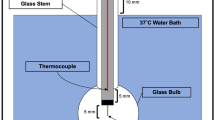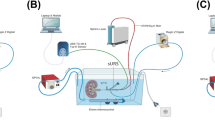Abstract
Purpose
To evaluate the thermal effect of Ho:YAG laser lithotripsy in a standardized in vitro model via real-time temperature measurement.
Methods
Our model comprised a 20 ml test tube simulating the renal pelvis that was immersed in a 37 °C water bath. Two different laser fibers [FlexiFib (15–45 W), RigiFib 1000 (45–100 W), LISA laser products OHG, Katlenburg-Lindau, Germany] were placed in the test tube. An Ho:YAG 100 W laser was used in all experiments (LISA). Each experiment involved 120 s of continuous laser application, and was repeated five times. Different laser settings (high vs. low frequency, high vs. low energy, and long vs. short pulse duration), irrigation rates (0 up to 100 ml/min, realized by several pumps), and human calcium oxalate stone samples were analyzed. Temperature data were acquired by a real-time data logger with thermocouples (PICO Technology, Cambridgeshire, UK). Real-time measurements were assessed using MatLab®.
Results
Laser application with no irrigation results in a rapid increase in temperature up to ∆28 K, rising to 68 °C at 100 W. Low irrigation rates yield significantly higher temperature outcomes. Higher irrigation rates result immediately in a lower temperature rise. High irrigation rates of 100 ml/min result in a temperature rise of 5 K at the highest laser power setting (100 W).
Conclusions
Ho:YAG laser lithotripsy might be safe provided that there is sufficient irrigation. However, high power and low irrigation resulted in potentially tissue-damaging temperatures. Laser devices should, therefore, always be applied in conjunction with continuous, closely monitored irrigation whenever performing Ho:YAG laser lithotripsy.


Similar content being viewed by others
Abbreviations
- CEM43 :
-
Cumulative equivalent at 43 °C
- PNL:
-
Percutaneous nephrolithotomy
- RIRS:
-
Retrograde intrarenal surgery
References
Oberlin DT, Flum AS, Bachrach L, Matulewicz RS, Flury SC (2015) Contemporary surgical trends in the management of upper tract calculi. J Urol 193(3):880–884. https://doi.org/10.1016/j.juro.2014.09.006
Turk C, Petrik A, Sarica K, Seitz C, Skolarikos A, Straub M, Knoll T (2016) EAU guidelines on interventional treatment for urolithiasis. Eur Urol 69(3):475–482. https://doi.org/10.1016/j.eururo.2015.07.041
Kronenberg P, Traxer O (2014) Update on lasers in urology 2014: current assessment on holmium:yttrium-aluminum-garnet (Ho:YAG) laser lithotripter settings and laser fibers. World J Urol. https://doi.org/10.1007/s00345-014-1395-1
Turk C, Knoll T, Petrik A, Sarica K, Skolarikos A, Straub M, Seitz C (2015) EAU guidelines on urolithiasis 2015
Vassar GJ, Chan KF, Teichman JM, Glickman RD, Weintraub ST, Pfefer TJ, Welch AJ (1999) Holmium: YAG lithotripsy: photothermal mechanism. J Endourol Endourol Soc 13(3):181–190. https://doi.org/10.1089/end.1999.13.181
Chan KF, Vassar GJ, Pfefer TJ, Teichman JM, Glickman RD, Weintraub ST, Welch AJ (1999) Holmium:YAG laser lithotripsy: a dominant photothermal ablative mechanism with chemical decomposition of urinary calculi. Lasers Surg Med 25(1):22–37
Molina WR, Silva IN, Donalisio da Silva R, Gustafson D, Sehrt D, Kim FJ (2015) Influence of saline on temperature profile of laser lithotripsy activation. J Endourol Endourol Soc 29(2):235–239. https://doi.org/10.1089/end.2014.0305
Cordes J, Nguyen F, Sievert K-D (2015) First intraluminal temperature measurement during Ho:YAG-laser exposure at an in vitro URS. Open J Urol 05(01):1–5. https://doi.org/10.4236/oju.2015.51001
Thomsen S, Pearce JA (2011) Thermal damage and rate processes in biologic tissues. In: Welch AJ, van Gemert MJC (eds) Optical-thermal response of laser-irradiated tissue. Springer, Dordrecht, pp 487–549. https://doi.org/10.1007/978-90-481-8831-4_13
Bauer KD, Henle KJ (1979) Arrhenius analysis of heat survival curves from normal and thermotolerant CHO cells. Radiat Res 78(2):251–263. https://doi.org/10.2307/3575042
van Rhoon GC, Samaras T, Yarmolenko PS, Dewhirst MW, Neufeld E, Kuster N (2013) CEM43°C thermal dose thresholds: a potential guide for magnetic resonance radiofrequency exposure levels? Eur Radiol 23(8):2215–2227. https://doi.org/10.1007/s00330-013-2825-y
Sapareto SA, Dewey WC (1984) Thermal dose determination in cancer therapy. Int J Radiat Oncol Biol Phys 10(6):787–800
Kallidonis P, Amanatides L, Panagopoulos V, Kyriazis I, Vrettos T, Fligou F, Kamal W, Liatsikos EN (2015) Does the heat generation by the Thulium:Yttrium aluminum garnet laser in the irrigation fluid allow its use on the upper urinary tract? An experimental study. J Endourol 30(4):422–427. https://doi.org/10.1089/end.2015.0252
Wollin DA, Carlos EC, Tom WR, Simmons WN, Preminger GM, Lipkin ME (2017) Effect of laser settings and irrigation rates on ureteral temperature during holmium laser lithotripsy, an in vitro model. J Endourol. https://doi.org/10.1089/end.2017.0658
Buttice S, Sener TE, Proietti S, Dragos L, Tefik T, Doizi S, Traxer O (2016) Temperature changes inside the kidney: what happens during holmium:yttrium-aluminium-garnet laser usage? J Endourol Endourol Soc 30(5):574–579. https://doi.org/10.1089/end.2015.0747
Kallidonis P, Kamal W, Panagopoulos V, Vasilas M, Amanatides L, Kyriazis I, Vrettos T, Fligou F, Liatsikos E (2016) Thulium laser in the upper urinary tract: does the heat generation in the irrigation fluid pose a risk? Evidence from an in vivo experimental study. J Endourol 30(5):555–559. https://doi.org/10.1089/end.2015.0768
Aldoukhi AH, Ghani KR, Hall TL, Roberts WW (2017) Thermal response to high-power holmium laser lithotripsy. J Endourol Endourol Soc 31(12):1308–1312. https://doi.org/10.1089/end.2017.0679
Ng YH, Somani BK, Dennison A, Kata SG, Nabi G, Brown S (2010) Irrigant flow and intrarenal pressure during flexible ureteroscopy: the effect of different access sheaths, working channel instruments, and hydrostatic pressure. J Endourol 24(12):1915–1920. https://doi.org/10.1089/end.2010.0188
Nair CGR, Ninan KN (1978) Thermal decomposition studies: Part X. Thermal decomposition kinetics of calcium oxalate monohydrate—correlations with heating rate and samples mass. Thermochim Acta 23(1):161–169. https://doi.org/10.1016/0040-6031(78)85122-3
Acknowledgements
We would like to thank Michaela von Aichberger for illustration of Fig. 1.
Funding
Institutional funding, Faculty of Medicine, University of Freiburg, Germany.
Author information
Authors and Affiliations
Contributions
SH: protocol/project development, data collection and management, data analysis, and manuscript writing/editing. RP: data collection and management, data analysis, manuscript and figure writing/editing, and performed experiments. MS: manuscript writing/editing and supervision. UW: manuscript writing/editing and supervision. AM: protocol/project development, manuscript writing/editing, and supervision.
Corresponding author
Ethics declarations
Conflict of interest
This work was supported by material support of LISA Laser products (Katlenburg-Lindau, Germany). Ulrich Wetterauer advisory board, DR. KADE Pharmazeutische Fabrik GmbH, Berlin, Germany (unrelated to the presented work). Martin Schoenthaler consultant contract with and NeoTract Inc., Pleasanton, USA (unrelated to the present work). Arkadiusz Miernik consultant contract with KLS Martin GmbH, Tuttlingen, Germany (unrelated to the present work).
Ethical approval
IRB approved protocol number: 79/16 leading ethics committee: Ethik-Kommission der Albert-Ludwigs-Universität Freiburg, Germany.
Research involved in human and animals rights
There are no human participants or animals involved into the study. Human stone probes were analyzed after ethical approval (79/16 leading ethics committee: Ethik-Kommission der Albert-Ludwigs-Universität Freiburg, Germany) and written informed consent.
Additional information
Simon Hein and Ralf Petzold have contributed equally to this work.
Rights and permissions
About this article
Cite this article
Hein, S., Petzold, R., Schoenthaler, M. et al. Thermal effects of Ho: YAG laser lithotripsy: real-time evaluation in an in vitro model. World J Urol 36, 1469–1475 (2018). https://doi.org/10.1007/s00345-018-2303-x
Received:
Accepted:
Published:
Issue Date:
DOI: https://doi.org/10.1007/s00345-018-2303-x




